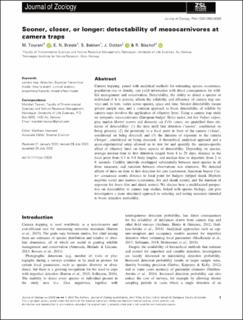| dc.description.abstract | Camera trapping, paired with analytical methods for estimating species occurrence, population size or density, can yield information with direct consequences for wildlife management and conservation. Detectability, the ability to detect a species or individual if it is present, affects the reliability and efficiency of camera trap surveys and, in turn, varies across species, space and time. Greater detectability means greater sample size, and a common approach to boost detectability of wildlife by camera traps involves the application of olfactory lures. Using a camera trap study on sympatric mesocarnivores (European badger Meles meles, red fox Vulpes vulpes, pine marten Martes martes and domestic cat Felis catus), we quantified three elements of detectability: (1) the time until first detection (‘sooner’, conditional on being present), (2) the proximity to a focal point in front of the camera (‘closer’, conditional on being detected) and (3) the duration of exposure to the camera (‘longer’, conditional on being detected). A hierarchical analytical approach and a quasi-experimental setup allowed us to test for and quantify the species-specific effect of olfactory lures on these aspects of detectability. Depending on species, average median time to first detection ranged from 4 to 28 days, distance to the focal point from 0.3 to 0.8 body lengths, and median time to departure from 2 to 6 seconds. Credible intervals overlapped substantially between most species in all three measures, and variation between observations was extensive. We detected effects of lures on time to first detection for cats (castoreum; American beaver Castor canadensis scent), distance to focal point for badgers (striped skunk Mephitis mephitis scent) and martens (castoreum, fox and skunk scents), and the duration of exposure for foxes (fox and skunk scents). We discuss how a multifaceted perspective on detectability in camera trap studies, linked with species biology, can give investigators a more structured approach to selecting and testing measures intended to boost detection probability. camera trap; detection; Bayesian hierarchical model; time to event; survival analysis; proportional hazards; mixed effect model. | |
